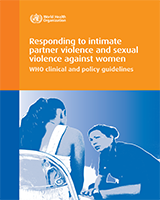All rights reserved. Publications of the World Health Organization are available on the WHO web site (www.who.int) or can be purchased from WHO Press, World Health Organization, 20 Avenue Appia, 1211 Geneva 27, Switzerland (tel.: +41 22 791 3264; fax: +41 22 791 4857; e-mail: tni.ohw@sredrokoob). Requests for permission to reproduce or translate WHO publications –whether for sale or for non-commercial distribution – should be addressed to WHO Press through the WHO web site (www.who.int/about/licensing/copyright_form/en/index.html).
NCBI Bookshelf. A service of the National Library of Medicine, National Institutes of Health.
A health-care provider is likely to be the first professional contact for survivors of intimate partner violence or sexual assault. Evidence suggests that women who have been subjected to violence seek health care more often than non-abused women, even if they do not disclose the associated violence. They also identify health-care providers as the professionals they would most trust with disclosure of abuse.
These guidelines are an unprecedented effort to equip healthcare providers with evidence-based guidance as to how to respond to intimate partner violence and sexual violence against women.
They also provide advice for policy makers, encouraging better coordination and funding of services, and greater attention to responding to sexual violence and partner violence within training programmes for health care providers.
The guidelines are based on systematic reviews of the evidence, and cover:
- identification and clinical care for intimate partner violence
- clinical care for sexual assault
- training relating to intimate partner violence and sexual assault against women
- policy and programmatic approaches to delivering services
- mandatory reporting of intimate partner violence.
The guidelines aim to raise awareness of violence against women among health-care providers and policy-makers, so that they better understand the need for an appropriate health-sector response. They provide standards that can form the basis for national guidelines, and for integrating these issues into health-care provider education.
Contents
- Acknowledgements
- Abbreviations and glossary
- Executive summary
- Background
- Methods
- Evidence and recommendations
- 1 Women-centred care
- 2 Identification and care for survivors of intimate partner violence
- 3 Clinical care for survivors of sexual assault
- 4 Training of health-care providers on intimate partner violence and sexual violence
- 5 Health-care policy and provision
- 6 Mandatory reporting of intimate partner violence
- Research implications
- Dissemination and implementation of the guidelines
- Monitoring and evaluating implementation of the guidelines
- Updating of the guidelines
- Annexes
The designations employed and the presentation of the material in this publication do not imply the expression of any opinion whatsoever on the part of the World Health Organization concerning the legal status of any country, territory, city or area or of its authorities, or concerning the delimitation of its frontiers or boundaries. Dotted lines on maps represent approximate border lines for which there may not yet be full agreement.
The mention of specific companies or of certain manufacturers' products does not imply that they are endorsed or recommended by the World Health Organization in preference to others of a similar nature that are not mentioned. Errors and omissions excepted, the names of proprietary products are distinguished by initial capital letters.
All reasonable precautions have been taken by the World Health Organization to verify the information contained in this publication. However, the published material is being distributed without warranty of any kind, either expressed or implied. The responsibility for the interpretation and use of the material lies with the reader. In no event shall the World Health Organization be liable for damages arising from its use.
- NLM CatalogRelated NLM Catalog Entries
- 'They aren't really black fellas but they are easy to talk to': Factors which influence Australian Aboriginal women's decision to disclose intimate partner violence during pregnancy.[Midwifery. 2016]'They aren't really black fellas but they are easy to talk to': Factors which influence Australian Aboriginal women's decision to disclose intimate partner violence during pregnancy.Spangaro J, Herring S, Koziol-Mclain J, Rutherford A, Frail MA, Zwi AB. Midwifery. 2016 Oct; 41:79-88. Epub 2016 Aug 6.
- Healthcare Responses to Gender-Based Violence in Timor-Leste: Women Want Empathy, Information and Safety From an Integrated Support System.[J Interpers Violence. 2022]Healthcare Responses to Gender-Based Violence in Timor-Leste: Women Want Empathy, Information and Safety From an Integrated Support System.Wild K, Young F, de Araujo G, Fernandes A, Gomes L, Kelly L, Taft A. J Interpers Violence. 2022 Dec; 37(23-24):NP22175-NP22198. Epub 2022 Mar 18.
- Intimate partner violence during pregnancy and associated mental health symptoms among pregnant women in Tanzania: a cross-sectional study.[BJOG. 2013]Intimate partner violence during pregnancy and associated mental health symptoms among pregnant women in Tanzania: a cross-sectional study.Mahenge B, Likindikoki S, Stöckl H, Mbwambo J. BJOG. 2013 Jul; 120(8):940-6. Epub 2013 Mar 6.
- Review Screening for and treating intimate partner violence in the workplace.[AAOHN J. 2003]Review Screening for and treating intimate partner violence in the workplace.Malecha A. AAOHN J. 2003 Jul; 51(7):310-6; quiz 317-8.
- Review How to identify, assess, and refer patients experiencing interpersonal violence across the lifespan: the role of US pharmacists in integrated pharmacy research and practice.[Integr Pharm Res Pract. 2019]Review How to identify, assess, and refer patients experiencing interpersonal violence across the lifespan: the role of US pharmacists in integrated pharmacy research and practice.Cerulli C, Inoue S, Cerulli J. Integr Pharm Res Pract. 2019; 8:115-125. Epub 2019 Nov 15.
- Responding to Intimate Partner Violence and Sexual Violence Against WomenResponding to Intimate Partner Violence and Sexual Violence Against Women
- Homologene neighbors for GEO Profiles (Select 119179110) (0)GEO Profiles
- Homologene neighbors for GEO Profiles (Select 119190493) (0)GEO Profiles
- Chromosome neighbors for GEO Profiles (Select 119177794) (20)GEO Profiles
- Chromosome neighbors for GEO Profiles (Select 72046676) (20)GEO Profiles
Your browsing activity is empty.
Activity recording is turned off.
See more...
